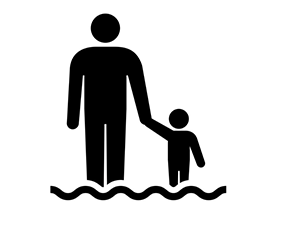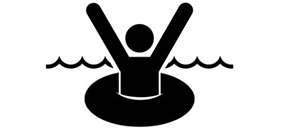Stay Safe This Summer
Statistics show that drowning is the leading cause of unintentional injury and death for children ages one to four, and that drowning can occur in as little as two inches of water.
The majority of drownings occur when a child was not expected to be in the pool. Drowning is a silent killer and can occur in less than a minute. Layers of protection are the best way to prevent drownings.
It is important to keep an eye on children and especially toddlers when around any kind of water — small kiddie pools, toilets, buckets of water when washing the car and the like.
For more information on family water safety schedule an appointment with one of our primary care pediatricians.
(631) 444-KIDS
Designate “Water Watchers”

Designate a “Water Watcher” at the pool. To prevent attention fatigue during a gathering, it’s best to designate several adults who can switch off with each other every 15-20 minutes.
Water Watchers Should:
- Be one specified person at a time.
- Only watch the pool; do not socialize, read or use electronic devices.
- Have a cell phone nearby, only to use in case of an emergency.
- Stay sober.
- Know where the safety devices are and how to use them.
Safety Devices

We recommend having a shepherd’s hook or a life hook, a life-saving ring and CPR instructions mounted at poolside. Keep in mind that floaties and floating toys are not approved safety devices.
But kiddie pools are safe, aren’t they?
Not necessarily. Kids can drown in just an inch of water. Kids using inflatable or plastic kiddie pools should be watched as carefully as they are in larger pools. For toddlers, age 1-4 years, use “touch supervision” in and around all pools; always staying within arm’s reach.
When It Isn't Swim Time

Pool fences are the most effective and proven way to prevent drownings.
- Pool fences should surround the pool on all sides and separate it from the yard and house.
- Do not rely on the house to serve as a barrier.
- Fences should be at least 4 feet high and not climbable; chainlink fences are not recommended.
- Fence gates should be at least 54 inches from the ground.
More detailed information from the American Academy of Pediatrics
What do I do if someone is drowning?
Get the person out of the water as soon as possible to get oxygen to their brain. If you can safely get the person onto land, do so; if not, immediately call for help.
If there is a lifeguard present, enlist his or her aid. They are trained in water rescue and resuscitation. Otherwise, call 911 immediately.
With near drowning, the victim suffers oxygen deprivation, which can cause long-term brain damage. In these cases, every minute counts.
Whenever possible, the victim should be taken to a Level 1 Trauma Center. This designation indicates the highest level of care.
What are some other water safety tips?
At the beach:
- If a lifeguard is present, never assume that he or she will serve as your eyes.
- Keep in mind that water reflects the sun’s rays. For protection against harmful rays, be sure to use a broad-spectrum sunscreen with an SPF of 30 or more. Reapply frequently, especially after going into the water.
- If you will be outdoors for a good part of the day, be sure to stay hydrated to prevent heat stroke or exhaustion — especially if you are also exercising
Pools:
- Always keep a phone near the pool
- If you have a pool, complete four-sided isolation fencing can prevent 50 to 90 percent of child drownings or near drownings.
- You may consider investing in safety covers for pools, whirlpools and spa tubs.
House:
- If you have an infant or toddler, use a toilet seat lock.
LEARN MORE
For more information on how to keep your family water safe, call (631) 444-KIDS to schedule an appointment with one of our primary care pediatricians.
For more information about Stony Brook Medicine, call (631) 444-4000.

